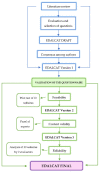Validation of a Questionnaire of Food Education Content on School Catering Websites in Spain
- PMID: 35329372
- PMCID: PMC8954418
- DOI: 10.3390/ijerph19063685
Validation of a Questionnaire of Food Education Content on School Catering Websites in Spain
Abstract
The aim of this study was to design and validate a questionnaire on quality and food education on catering company websites. For the validation of the questionnaire, its reliability, feasibility and content validity characteristics were determined. For content validity, a panel of experts was used and the overall and item-wise Content Validity Index (CVI) of the experts' responses was calculated. Reliability was determined by the inter-judge agreement method with the analysis of 30 websites using the intraclass correlation coefficient (ICC) and the Bland and Altman plot. Adequate content validity was verified by obtaining a very high CVI (above 0.80) in the analysis of the expert panel's responses and excellent inter-observer agreement with a very high global ICC (above 0.90) value in the determination of test-retest reliability. The questionnaire is a valid instrument for the evaluation of the quality of school catering websites and their content in food education, as it has good feasibility, high content validity and excellent reliability.
Keywords: catering; food education; health promotion; validation questionnaire; websites.
Conflict of interest statement
The authors declare no conflict of interest.
Figures
Similar articles
-
Development and psychometric testing of the Knowledge, Attitudes and Practices (KAP) questionnaire among student Tuberculosis (TB) Patients (STBP-KAPQ) in China.BMC Infect Dis. 2018 May 8;18(1):213. doi: 10.1186/s12879-018-3122-9. BMC Infect Dis. 2018. PMID: 29739363 Free PMC article.
-
Validity and Reliability of a Food Skills Questionnaire.J Nutr Educ Behav. 2019 Jul-Aug;51(7):857-864. doi: 10.1016/j.jneb.2019.02.003. Epub 2019 Mar 22. J Nutr Educ Behav. 2019. PMID: 30910315
-
The conception, content validation, and test-retest reliability of the Questionnaire for Screen Time of Adolescents (QueST).J Pediatr (Rio J). 2022 Mar-Apr;98(2):175-182. doi: 10.1016/j.jped.2021.05.004. Epub 2021 Jun 24. J Pediatr (Rio J). 2022. PMID: 34174211 Free PMC article.
-
Instrument validation process: a case study using the Paediatric Pain Knowledge and Attitudes Questionnaire.J Clin Nurs. 2016 Jun;25(11-12):1566-75. doi: 10.1111/jocn.13130. Epub 2016 Feb 3. J Clin Nurs. 2016. PMID: 26841101 Review.
-
Development and validation of an instrument to measure pediatric nurses' adherence to ethical codes.BMC Med Ethics. 2022 Feb 25;23(1):14. doi: 10.1186/s12910-022-00753-4. BMC Med Ethics. 2022. PMID: 35216609 Free PMC article. Review.
References
-
- Manson A., Johnson B., Zarnowiecki D., Sutherland R., Golley R. The food and nutrient intake of 5- to 12 year-old Australian children during school hours: A secondary análisis of the 2011–2012 National Nutrition and Physical Activity Survey. Public Health Nutr. 2021;24:5985–5994. doi: 10.1017/S1368980021003888. - DOI - PMC - PubMed
-
- Durá T., Sánchez-Valverde F. Obesidad infantil: ¿Un problema de educación individual, familiar o social? [(accessed on 1 October 2021)];Acta Pediatr. Esp. 2005 63:204–207. Available online: https://studylib.es/doc/4484868/obesidad-infantil--%C2%BFun-problema-de-...
-
- Macias M.A.I., Gordillo S.L.G., Camacho R.E.J. Hábitos alimentarios de niños en edad escolar y el papel de la educación para la salud. Rev. Chil. Nutr. 2012;39:40–43. doi: 10.4067/S0717-75182012000300006. - DOI
-
- Pozo S.D., Cuadrado C., Rodríguez M., Quintanilla L., Ávila J.M., Moreiras O. Planificación nutricional de los menús escolares para los centros públicos de la Comunidad de Madrid. [(accessed on 24 October 2021)];Nutr. Hosp. 2006 21:667–672. Available online: http://scielo.isciii.es/scielo.php?script=sci_arttext&pid=S0212-16112006.... - PubMed
MeSH terms
LinkOut - more resources
Full Text Sources




